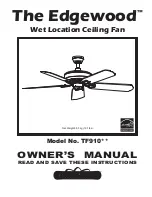
3
VARD / VARW.. – High-Pressure In-Line Duct Fans
Installation and Operating Instructions
1.6
Personnel qualification
–
All electrical work as well as the start-up must only be carried out by qualified electricians.
–
Installation, servicing and maintenance may be carried out by specialists (e.g.: industrial mechanics, mechatronics
engineers, metal workers or persons with comparable training) with the exception of electrical work.
1.7
Air-flow direction and direction of rotation
WARNING
Parts ejected from the fan may damage your eyes!
Wear protective glasses when checking the direction of rotation!
WARNING
The rotating impeller can sever or trap your fingers/arms!
Operation only with mounted safety fittings!
Risk of damage! Do not insert objects into the rotating impeller!
The air flow direction blows via the motor (see air flow and rotation direction arrow). The correct rotation direction is –
when viewing impeller from the front – left in counter-clockwise direction.
The direction of rotation may only be checked when the fan is switched off and coasting!
Three-phase current models must be connected by interchanging two phases for anticlockwise rotation in case of el-
ectrical connection in the clockwise field of rotation.
Incorrect rotation direction can lead to the motor overheating!
1.8
Speed control*
– 1-phase types
All fans of type VARW can be voltage-controlled by means of transformer or phase control. The relevant controllers can
be found in the Helios sales documents. When dimensioning the control unit, the maximum current for speed control ac-
cording to the type plate must be observed.
– 3-phase types
All fans of type VARD can be speed-controlled in at least one of the following ways.
a) Transformer/phase control: For all voltage-controllable fan types, the relevant controllers can be found in the Helios
sales documents. Fan types with no assigned control device are not voltage-controllable.
Speed control can only ta-
ke place in large steps with switch type Y/D .
b) Speed control switch: All fans of switch type Y/D; Y/YY can be controlled in two speed stages using the switch.
c) Frequency converter: All fans of type VARD with the exception of switching type Y/YY, can be speed-controlled with
a frequency converter with sine filter. The use of a frequency converter without sine filter is only possible with approval
from Helios.
The use of third party products, especially other electronic devices, can lead to functional problems, the
destruction of the controller and/or fan. If control units are used, which have not been approved by Helios, all
warranty and liability claims shall lapse.
1.9
Motor protection device*
– 1-phase motors
All 1-phase motors have thermal contacts, which are wired in series with the coil and switch off automatically and re-
start after cooling. Fans with thermal contacts wired on terminals, can be monitored and secured against being switched
on again by using a motor protection device
MW
. See Helios sales documents.
– 3-phase motors
a) Motors without integrated temperature controllers (thermal contact or thermistor): Protection by motor protection
switch. In case of multi-speed motors, each speed must be separately protected. Set motor protection switch to no-
minal current. Test switch trigger function. This protection is not suitable for speed-controlled operation and does not
protect the motor in case of high flow medium temperatures or a lack of cooling.
b) Fans with thermal contacts wired on terminals: The specifically developed motor protection devices
–
MD = for 400 V/3~, 1-speed
–
M 2 = for 2-speed separate winding 400 V/3~
–
M 3 = for 2-speed Dahlander winding 400 V
–
M 4 = for 2-speed Y/∆-switch 400 V/3~
are recommended for connection.
c) Fans with thermistors wired on terminals:
The specially developed motor protection switch
MSA
is recommended for connection.
ATTENTION!
The max. test voltage for thermistors of 2.5 V must not be exceeded, as otherwise the thermistor and
motor winding will be destroyed!
UK
WARNING
WARNING
ATTENTION
l
ATTENTION
ATTENTION
* The associated control units can be found
in the currently applicable Helios sales docu-
ments.
* The associated motor protection devices
can be found in the currently applicable
Helios sales documents.
ATTENTION
ATTENTION
















































